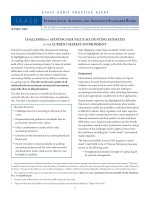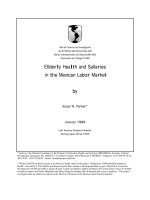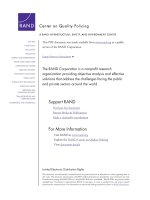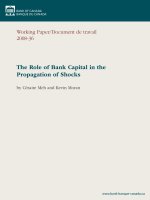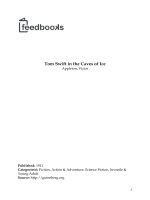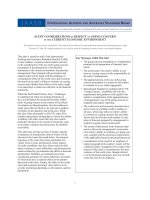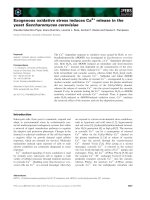Cloud-sourcing Research Collections: Managing Print in the Mass-digitized Library Environment potx
Bạn đang xem bản rút gọn của tài liệu. Xem và tải ngay bản đầy đủ của tài liệu tại đây (3.43 MB, 76 trang )
Cloud-sourcing Research Collections:
Managing Print in the Mass-digitized
Library Environment
Constance Malpas
Program Officer
OCLC Research
A publication of OCLC Research
Cloud-sourcing Research Collections: Managing Print in the Mass-digitized Library Environment
January 2011
Constance Malpas, for OCLC Research Page 2
Cloud-sourcing Research Collections: Managing Print in the Mass-digitized Library Environment
Constance Malpas, for OCLC Research
© 2011 OCLC Online Computer Library Center, Inc.
Reuse of this document is permitted as long as it is consistent with the terms of the Creative
Commons Attribution-Noncommercial-Share Alike 3.0 (USA) license (CC-BY-NC-SA):
January 2011
OCLC Research
Dublin, Ohio 43017 USA
www.oclc.org
ISBN: 1-55653-394-2 (978-1-55653-394-5)
OCLC (WorldCat): 695086590
Please direct correspondence to:
Constance Malpas
Program Officer
Suggested citation:
Malpas, Constance. 2011. Cloud-so
urcing Research Collections: Managing Print in the Mass-
digitized Library Environment. D
ublin, Ohio: OCLC Research.
Cloud-sourcing Research Collections: Managing Print in the Mass-digitized Library Environment
January 2011
Constance Malpas, for OCLC Research Page 3
Contents
Acknowledgments 7
Executive Summary 8
Introduction 13
Premise 14
Methodology 14
Scope of Analysis 15
Summary of Findings 17
Shared Digital Repository Profile: HathiTrust 17
Shared Print Repository Profile: ReCAP 32
Model Consumer Profile: NYU 45
Shared Print Provision: Assessing the Options 50
Expanding the Scope of Shared Service 50
Assessing Market Maturity 51
Alternative Service Providers 52
Optimizing Existing Infrastructure 55
What is It Worth? Putting a Price on Shared Collection Services 58
Who Will Benefit? Who Will Pay? 61
Conclusions and Recommendations 64
Appendix I. HathiTrust Cost Rationale 67
Appendix II. Cloud Library Service Agreements: ReCAP as Shared Print Repository 71
Cloud-sourcing Research Collections: Managing Print in the Mass-digitized Library Environment
January 2011
Constance Malpas, for OCLC Research Page 4
References 76
Cloud-sourcing Research Collections: Managing Print in the Mass-digitized Library Environment
January 2011
Constance Malpas, for OCLC Research Page 5
Figures
Figure 1. Growth of HathiTrust Digital Library collection (June 2009 - June 2010) 18
Figure 2. Projected growth of HathiTrust Digital Library (June 2010 - June 2020) 19
Figure 3. Primary document types of titles in HathiTrust Digital Library (June 2010) 20
Figure 4. Distribution of HathiTrust Digital Library titles by document type (June 2009 - June
2010) 21
Figure 5. Subject distribution of titles in HathiTrust Digital Library (June 2010) 22
Figure 6. Distribution of titles in HathiTrust Digital Library by subject and copyright status
(June 2010) 27
Figure 7. Top ten categories of public domain content in HathiTrust Digital Library (June
2010) 29
Figure 8. System-wide distribution of library holdings for titles in HathiTrust Digital Library
(June 2010) 31
Figure 9. Distribution of ReCAP holdings by contributor (July 2010) 33
Figure 10. Growth in titles duplicated in ReCAP and HathiTrust Digital Library (September
2009 - June 2010) 34
Figure 11. Primary document types of titles duplicated in ReCAP and HathiTrust Digital
Library (June 2010) 37
Figure 12. Subject distribution of Hathi titles held in ReCAP (June 2010) 38
Figure 13. Comparative scope of shared digital and shared print repository collections (June
2010) 40
Figure 14. Titles duplicated in ReCAP and the HathiTrust Digital Library (June 2010) 42
Figure 15. System-wide distribution of library holdings for Hathi titles in ReCAP (June 2010) 44
Cloud-sourcing Research Collections: Managing Print in the Mass-digitized Library Environment
January 2011
Constance Malpas, for OCLC Research Page 6
Figure 16. Growth in coverage of NYU Bobst holdings in HathiTrust Digital Library (June 2009
– June 2010) 46
Figure 17. NYU Bobst titles duplicated in ReCAP and HathiTrust Digital Library (September
2009 – June 2010) 47
Figure 18. NYU Bobst titles duplicated in UC SRLF and HathiTrust Digital Library (June 2009 -
June 2010) 53
Figure 19. Comparison of potential shared print provision options for NYU Bobst Library (June
2010) 54
Figure 20. NYU Bobst titles duplicated in ReCAP partner libraries and HathiTrust Digital
Library (June 2009 - June 2010) 56
Figure 21. Percentage duplication of titles held in ARL libraries and HathiTrust Digital Library
(June 2009 and June 2010) 62
Cloud-sourcing Research Collections: Managing Print in the Mass-digitized Library Environment
January 2011
Constance Malpas, for OCLC Research Page 7
Into being
The clouds condense, when in this upper space
Of the high heaven have gathered suddenly,
As round they flew, unnumbered particles—
World's rougher ones, which can, though interlinked
With scanty couplings, yet be fastened firm,
The one on other caught.
Lucretius De rerum natura, Book V
trans. William Ellery Leonard (1921)
Acknowledgments
The Cloud Library project emerged out of a series of discussions that began with Carol Mandel,
Jim Neal, John Wilkin and Jim Michalko in 2009. These individuals provided leadership and
vision that guided all the work that followed.
Library staff from New York University, Columbia University, the New York Public Library and
Princeton University participated in a variety of meetings, conference calls and e-mail
exchanges that helped to give shape to the project. The Andrew W. Mellon Foundation
contributed financial support under a grant ably administered by Chuck Henry at the Council
on Library and Information Resources (CLIR).
Michael Stoller, Bob Wolven, Zack Lane, Matthew Sheehy, Marvin Bielawski and Eileen
Henthorne made essential contributions to the project, not least in helping to compile ReCAP
holdings data for inclusion in our analysis. Kat Hagedorn and Jeremy York provided expert
technical and operational support from Hathi. Jenny Toves ensured that WorldCat data
extractions were available on schedule.
I am grateful to Jim Michalko, John Wilkin and Paul Courant for their many thoughtful
questions and suggestions about the data analysis and interpretation. Lorcan Dempsey and
Brian Lavoie also provided insights and helpful methodological guidance along the way.
Particular thanks are due to Roy Tennant and Bruce Washburn, who provided expert
programming support over the course of this project and routinely produced small miracles,
and to Patrick Confer for his diligent editorial work in preparing the final report.
Cloud-sourcing Research Collections: Managing Print in the Mass-digitized Library Environment
January 2011
Constance Malpas, for OCLC Research Page 8
Executive Summary
The Cloud Library project was jointly designed and executed by OCLC Research, the
HathiTrust, New York University’s Elmer Holmes Bobst Library, and the Research Collections
Access & Preservation (ReCAP) consortium, with support from The Andrew W. Mellon
Foundation. The objective of the project was to examine the feasibility of outsourcing
management of low-use print books held in academic libraries to shared service providers,
including large-scale print and digital repositories.
The following overarching hypothesis provided a framework for our investigation:
• The emergence of a mass-digitized book corpus has the potential to transform the
academic library enterprise, enabling an optimization of legacy print collections that
will substantially increase the efficiency of library operations and facilitate a
redirection of library resources in support of a renovated library service portfolio.
From this, a number of research questions emerged:
• What is the scope of the mass-digitized book corpus in the HathiTrust Digital Libray
and to what degree does it replicate print collections held in academic research
libraries?
• Can public domain content in the HathiTrust Digital Library provide a suitable
surrogate for low-use print collections in academic libraries?
• Is there sufficient duplication between shared print storage repositories and the
HathiTrust Digital Library to permit a significant number of academic libraries to
optimize and reduce total spending on local print management operations?
• What operational gains might be obtained through a selective externalization of
collection management activities?
Based on a year-long study of data from the HathiTrust, ReCAP, and WorldCat, we concluded
that our central hypothesis was successfully confirmed: there is sufficient material in the
Cloud-sourcing Research Collections: Managing Print in the Mass-digitized Library Environment
January 2011
Constance Malpas, for OCLC Research Page 9
mass-digitized library collection managed by the HathiTrust to duplicate a sizeable (and
growing) portion of virtually any academic library in the United States, and there is adequate
duplication between the shared digital repository and large-scale print storage facilities to
enable a great number of academic libraries to reconsider their local print management
operations. Significantly, we also found that the combination of a relatively small number of
potential shared print providers, including the Library of Congress, was sufficient to achieve
more than 70% coverage of the digitized book collection, suggesting that shared service may
not require a very large network of providers.
Analysis of the distribution of subject matter and library holdings represented in the
HathiTrust Digital Library and shared print repositories further confirmed that the digital
corpus is largely representative of the collective academic library collection, suggesting a
broad potential market for service. A further positive finding was that monographic titles in
the humanities constitute the greatest part of the mass-digitized resource, which may
indicate that some relatively under-resourced disciplines will begin to benefit from a digital
transformation that has already powered enormous innovation in the sciences. As detailed
below, we also found that substantial library space savings and cost avoidance could be
achieved if academic institutions outsourced management of redundant low-use inventory to
shared service providers.
Our findings also revealed some important obstacles and limitations to implementing changed
print management practices in the current library operating environment. The following are
among the most important constraints we identified:
• The proportion of public domain content in the HathiTrust Digital Library is relatively
small (approximately 16% of titles in June 2010) and typically represents material that
is not widely held in the library system; as a result, the number of libraries that might
hope to reduce local print management costs for these titles through negotiated
agreements with the HathiTrust and shared print providers is quite low. Moreover, the
age and subject distribution of titles in the public domain is not representative of
academic research collections as a whole. In sum, the public domain corpus as
currently defined by U.S. copyright law cannot be considered a viable surrogate for
any academic print collection.
• While significant duplication was found between the HathiTrust Digital Library and
multiple large-scale library storage collections, it was apparent that no single print
storage repository could offer coverage sufficient to enable significant space savings or
cost avoidance for a given client library. Put another way, effective shared print
storage solutions will depend upon a network of providers who will need to optimize
holdings as a collective resource.
Cloud-sourcing Research Collections: Managing Print in the Mass-digitized Library Environment
January 2011
Constance Malpas, for OCLC Research Page 10
• The absence of a robust discovery and delivery service based on collective print
storage holdings is an impediment to changed print management strategies, especially
for digitized titles in copyright.
It is our strong conviction, based on the above findings, that academic libraries in the United
States (and elsewhere) should mobilize the resources and leadership necessary to implement
a bridge strategy that will maximize the return on years of investment in library print
collections while acknowledging the rapid shift toward online provisioning and consumption of
information. Even, and perhaps especially, in advance of any legal outcome on the Google
Book Search settlement, academic libraries have a unique opportunity to reconfigure print
supply chains to ensure continued library relevance in the print supply chain. In the absence
of a licensing option, online access to most of the digitized retrospective literature will be
severely constrained. Demand for print versions of digitized books will continue to exist and
libraries will be motivated to meet it, but they will need to do so in more cost-effective ways.
In the absence of fully available online editions, full-text indexing of digitized in-copyright
material provides a means of moderating and tuning demand for print versions and should
facilitate the transfer of an increasing part of the print inventory to high-density warehouses.
Viewed in this light, shared print storage repositories could enable a significant and positive
shift in library resources toward a more distinctive and institutionally relevant service
portfolio.
Our study assessed the opportunity for library space saving and cost avoidance through the
systematic and intentional outsourcing of local management operations for digitized books to
shared service providers and progressive downsizing of local print collections in favor of
negotiated access to the digitized corpus and regionally consolidated print inventory. As
detailed in the report that follows, the organizational change required to achieve these gains
is likely to be substantial and challenging to implement. Yet, the opportunity costs of inaction
may prove even greater than the risks of enacting shared print management regimes. Many of
the positive transformations that academic library directors hope to achieve in the next
decade or so will require a fundamental shift in collections management. The scope and scale
of change that is possible may be judged by these key findings:
• As of June 2010, the median rate of duplication between titles held by university
libraries in the U.S. Association of Research Libraries (ARL) and the HathiTrust Digital
Library exceeds 30%; that is to say, nearly a third of the content purchased by
research-intensive libraries in the United States has already been digitized and is
preserved in a shared digital repository.
• If the current growth trajectory of the HathiTrust Digital Library is sustained, we can
project that more than 60% of the retrospective print collections held in ARL libraries
Cloud-sourcing Research Collections: Managing Print in the Mass-digitized Library Environment
January 2011
Constance Malpas, for OCLC Research Page 11
will be duplicated in the shared digital repository by June 2014. This growth rate far
exceeds average annual acquisitions in ARL libraries, suggesting that the digital
replication of legacy collections will outpace growth of new physical collections,
enabling a transformation in traditional library operations, staffing and space
requirements.
• The median space savings that could be achieved at an ARL library if a robust shared
print offer were in place today amounts to approximately 36,000 linear feet or the
equivalent of more than 45,000 assignable square feet (ASF). These are conservative
estimates based on the assumption that holding libraries own a single copy of each
duplicated title. Actual space savings could be much greater. In practical terms, this
means each library could recover space sufficient for a learning or research commons,
media lab, or office space for faculty and visiting scholars.
• The total annual cost avoidance that could be achieved if shared print service
provision for mass-digitized books were available today would amount to a figure
between $500,000 and $2 million per ARL library, depending on the physical
environment (e.g., open stacks on campus or high-density off-site storage) in which
the titles would be managed locally.
Academic library directors can have a positive and profound impact on the future of academic
print collections by adopting and implementing a deliberate strategy to build and sustain
regional print service centers that can meet aggregate demand with aggregate supply. Beyond
the obvious operational efficiencies of consolidating low-use, digitized print volumes into
shared service collections there is an important strategic advantage to reconfiguring
collective inventory that is increasingly devalued as an institutional asset. A proactive effort
to rationalize collections that are undergoing a radical phase change from print to digital will
enable libraries to achieve a careful and measured wind-down of operations that no longer
deliver distinctive value, while continuing to uphold a vital preservation and access mandate.
The shared infrastructure needed to support a broad-based externalization of legacy print
management functions is unlikely emerge without directed action and decision-making by
leaders in the academic library community. Individuals and organizations interested in
advancing these changes are encouraged to consider the following recommendations:
Library directors and managers can . . .
• Advocate in favor of licensed access to the mass-digitized resource as part of a
comprehensive strategic plan in which the library can reassert its role as a vital part of
the academic enterprise.
Cloud-sourcing Research Collections: Managing Print in the Mass-digitized Library Environment
January 2011
Constance Malpas, for OCLC Research Page 12
• Engage directly with faculty and academic officers to communicate a compelling
strategy in which selective externalization of traditional functions is demonstrably
improving the institution’s ability to fulfill an academic and research mission.
• Support the HathiTrust’s ongoing efforts to expand public access to the mass-digitized
book corpus by affiliating with the organization as a content contributor or sustaining
partner.
Prospective shared print providers, including managers of large print storage facilities,
can . . .
• Proactively build collections that will deliver maximum operational value to external
audiences; leverage the collective library investment in mass digitization and the
HathiTrust by accelerating the transfer of mass-digitized titles to print preservation
repositories.
• Contribute to the establishment of a common service profile by surfacing model
agreements and engaging in community dialog about the operational and business
requirements of shared service provision.
Research organizations, including OCLC Research, Ithaka S+R, JISC and other similar entities,
can . . .
• Advance our collective understanding of the changing profile of demand for legacy
print collections in the mass-digitized environment.
• Help to characterize the optimal redistribution of library resources in different
regional and national contexts.
Funding bodies, including IMLS, the Mellon Foundation, NEH and others, can . . .
• Provide funding to support the implementation of shared print management through
grants to libraries and other organizations to subsidize the direct costs of title
selection and processing until such activities are fully subsumed as ongoing library
operations.
Cloud-sourcing Research Collections: Managing Print in the Mass-digitized Library Environment
January 2011
Constance Malpas, for OCLC Research Page 13
Introduction
In spring 2009, a group of ARL directors came together to discuss a common set of challenges
and opportunities facing university libraries and identify some shared strategies for
responding to them. A number of circumstances were converging that appeared to offer some
potential relief from critical space pressures in the library and the increasingly burdensome
operations associated with managing a large local inventory of low-use print collections.
The seemingly imminent resolution of the Google Book Search settlement was an important
motivating factor: academic libraries were confronting the prospect, at once daunting and
liberating, of licensed access to a massive aggregation of digitized books from major U.S.
research collections. Would such a collection substantially duplicate local print holdings? If so,
what consequences might ensue for traditional academic library operations?
At the same time, the emergence of the HathiTrust, a shared digital repository consolidating
much of the library-contributed content from the Google Books database, appeared to resolve
many of the concerns the library community had regarding long-term stewardship of the
mass-digitized book corpus. In combination with the large aggregations of low-use print
collections managed in high-density library storage facilities, Hathi might bridge the gap
between a well-documented decline in the use of academic print collections and the
anticipated shift toward scholarly reliance on full-text electronic resources.
The fact that critical elements of the shared infrastructure needed to effect a large-scale
transition from print to electronic research collections were owned and managed by the
library community itself gave library directors confidence that the timing and outcomes of
this transition could be managed according to the needs of the academic community and not
dictated by the business objectives of commercial providers. Were the combined resources of
Hathi and large-scale shared print providers already sufficient to mobilize a change in library
operations? What was the scope of service likely to be? How much and what kind of value
would it need to deliver? Who—which kinds of libraries and in what number—would benefit?
These questions were compelling enough to justify a joint research project in which potential
service providers and consumers could explore business requirements, service expectations
and feasibility of implementation.
Cloud-sourcing Research Collections: Managing Print in the Mass-digitized Library Environment
January 2011
Constance Malpas, for OCLC Research Page 14
The initiative that emerged from these discussions within ARL came to be known as the
“Cloud Library” project, because it posited a future in which library collections and services
would be sourced from external providers, reducing local infrastructure and operational
expenditures in a manner analogous to the cloud-sourced business and computing solutions
that now prevail in the commercial and high-tech sectors. Funded by The Andrew W. Mellon
Foundation, the project was staffed by a team of investigators from the HathiTrust, the
Research Collections Access and Preservation consortium (ReCAP), New York University
Libraries, and OCLC Research. This report provides a high-level summary of findings from this
project.
Premise
The research questions that motivated this study reflect a conviction shared by all of the
participating institutions: the emergence of a mass-digitized book corpus has the
potential to transform the academic library enterprise, enabling an optimization of
legacy print collections that will substantially increase the efficiency of library
operations and facilitate a redirection of library resources in support of a renovated
library service portfolio. We started from the presumption that academic libraries will be
motivated to transfer resources (space, personnel, and capital) from local print management
operations to shared print and digital repositories in proportion to the tangible benefit that
cooperative management confers. We were therefore less interested in examining the
theoretical advantages of shared service provision than in characterizing the operational gains
(space recovery and cost avoidance) that might be obtained through a selective
externalization of collection management activities.
Methodology
Between June 2009 and June 2010, a monthly snapshot of records was harvested by OCLC
Research from the publicly available HathiTrust metadata repository. These records were
machine-processed to extract OCLC numbers and, where necessary, to extract and map
alternative identifiers (LCCN, ISBN or ISSN) to valid OCLC numbers. The resulting batch of
OCLC numbers was used to extract bibliographic records and holdings data from the WorldCat
database each month. These bibliographic master records were then merged with selected
Hathi metadata and (starting in September 2009) a sample of associated ReCAP repository
customer codes to produce a single, consolidated dataset for analysis.
A master database was built to support analysis of the compiled data, which was
programmatically enhanced to support analysis of key attributes of the aggregate collection,
including broad subject areas, total library holdings, institutional source of the digitized text
and copyright status. This database was enriched each month with successive snapshots of the
Cloud-sourcing Research Collections: Managing Print in the Mass-digitized Library Environment
January 2011
Constance Malpas, for OCLC Research Page 15
Hathi repository, mapped to WorldCat holdings and ReCAP customer codes as described above.
By June 2010, the project database comprised 37 million records, representing a longitudinal
view of the growing corpus of library-owned titles that are duplicated in print and digital
repositories.
Scope of Analysis
In the twelve months covered by this project, the HathiTrust Digital Library doubled in size,
increasing from approximately 3 million volumes to more than 6 million volumes. On a per-
volume basis, the shared digital repository is now larger than the average ARL library
collection; the median reported holdings at university-based ARL libraries in 2008 was
approximately 3.5 million volumes. Because our analysis of the HathiTrust collection focuses
on unique titles (manifestations or editions), rather than physical items, the number of
records we compiled each month was somewhat smaller than the number of records in the
Hathi metadata repository. Not every volume in the HathiTrust represents an individual book
or journal title, and there is at least some duplication in content ingested from different
contributors; as a result, the total number of volumes in the Hathi repository is more than the
number of titles covered in our analysis. In June 2009, we identified approximately 2 million
unique titles in the HathiTrust Digital Library; by June 2010, that number had grown to more
than 3.6 million titles. For purposes of comparison, this represents a collection comparable
in scope to research libraries in the top tier of the U.S. ARL rankings, based on holdings
set in the WorldCat database. Indeed, at the time of writing, the number of unique titles in
the HathiTrust Digital Library exceeds the number of titles cataloged and held by many
research libraries.
A key goal of this research project was to assess the scope of coverage in shared print and
shared digital repositories, with a view to understanding how the combined resources might
enable a local reduction in redundant print inventory. For this reason, it was important to
understand how much of the print storage collection in ReCAP is duplicated—or is likely to be
duplicated—in the HathiTrust Digital Library. As of this writing, the shared ReCAP facility
holds more than 8 million items contributed by the three partner libraries. Since the ReCAP
collection is not currently visible as a discrete set of holdings in WorldCat, and building a
union catalog of ReCAP holdings was beyond the scope of this project, we based our analysis
on a representative sample of ReCAP holdings supplied by Columbia University and NYPL.
Taken collectively, Columbia and NYPL’s ReCAP holdings amount to more than 75% of current
inventory and this was deemed to be sufficient for our analysis.
The sample supplied to us included a broad range of materials managed under 14 different
ReCAP customer codes, each representing a different set of request and circulation rules. The
large size and broad scope of the sample gave us reasonable confidence that findings from our
Cloud-sourcing Research Collections: Managing Print in the Mass-digitized Library Environment
January 2011
Constance Malpas, for OCLC Research Page 16
analysis could be generalized across the ReCAP collection as a whole. Storage, selection and
transfer protocols at the three partner libraries are based on common parameters (low use
monographs; journals duplicated in electronic format), so that the nature, if not the content,
of the materials contributed by each is likely to be comparable.
To provide a baseline against which duplication of ReCAP holdings in the HathiTrust Digital
Library might be assessed, we periodically compared patterns in the ReCAP sample against
other large-scale print storage collections that are more readily subject to analysis in
WorldCat. Findings from these analyses are presented below.
Cloud-sourcing Research Collections: Managing Print in the Mass-digitized Library Environment
January 2011
Constance Malpas, for OCLC Research Page 17
Summary of Findings
In this section, the scope and character of holdings in the HathiTrust Digital Library and
ReCAP print repository are examined with a view to their potential value in a shared service
environment. We first consider the range of holdings in the HathiTrust Digital Library, on the
premise that the vast and still expanding scope of the mass-digitized corpus will be a key
driver in the transformation of academic library collections and services. We then examine
the intersection of titles held in the HathiTrust Digital Library and the ReCAP print repository
to assess the degree to which large-scale storage collections might serve as print management
hubs, reducing the total cost of preservation and access for low use print resources. Finally,
we explore how this shared infrastructure might affect library operations and resource
allocations in a research-intensive academic library, using NYU’s Elmer Holmes Bobst library
as an exemplar.
Shared Digital Repository Profile: HathiTrust
Over the period of study, the number of volumes in the HathiTrust Digital Library more than
doubled, growing from about 3 million items to more than 6.3 million items; the number of
titles increased by 90%, from just over 1.9 million titles in June 2009 to about 3.64 million
titles in June 2010. Growth was variable from month to month, ranging from a low of about
43,000 new titles in April 2010 to a high of more than 297,000 new titles in November 2009.
On average, the number of unique titles in the database increased by about 6% each month.
This represents an average increase of nearly 150,000 new titles each month. The ratio of
volumes to titles in the repository remained relatively stable at 1.6:1 over the twelve months
of this study.
Cloud-sourcing Research Collections: Managing Print in the Mass-digitized Library Environment
January 2011
Constance Malpas, for OCLC Research Page 18
Figure 1. Growth of HathiTrust Digital Library collection (June 2009 - June
2010)
If this rate of growth is sustained, we can expect the HathiTrust Digital Library to rival major
research library collections in both size (volumes) and scope (titles) in a matter of a few years.
Based on the projections shown below, we can anticipate that the HathiTrust Digital
Library collection may be equal in size to Harvard University Libraries (which reported
holdings of some 16 million volumes in the 2007-2008 ARL Annual Statistics) by 2013. Within
a decade, it could cross the threshold of 30 million volumes, making it larger than the
U.S. Library of Congress is today.
0
1,000,000
2,000,000
3,000,000
4,000,000
5,000,000
6,000,000
7,000,000
Volumes
Titles
Cloud-sourcing Research Collections: Managing Print in the Mass-digitized Library Environment
January 2011
Constance Malpas, for OCLC Research Page 19
Figure 2. Projected growth of HathiTrust Digital Library (June 2010 - June
2020)
For ease of presentation, these projections compare the growth of Hathi to a baseline of
constant volume counts at the largest university and non-university ARL collections. Of
course, it is reasonable to expect that volume counts for print holdings at these libraries will
continue to grow over the next decade; however, the current growth rate of the HathiTrust
Digital Library substantially outpaces median annual growth rates at ARL member libraries
(approximately 2% of total volume count, based on recent ARL statistics) so we can anticipate
that the overlap in digitization of retrospective print holdings will continue to grow faster
than the acquisition of new print titles.
i
Understanding the relative distribution of document types in the HathiTrust Digital Library
archive is important to characterizing and quantifying its value as a potential surrogate to
locally-held academic library print collections. Since the advent of the e-journal transition of
the 1990s, university libraries have regarded print versions of dual-format titles as obvious
targets for relegation to storage facilities. A major focus of the present study was to
determine the degree to which mass digitization of library print collections has resulted in the
creation of a digitized book corpus sufficient to enable a similar shift in management of
monographic holdings. It is not yet known if the emergence of a large-scale digital book
corpus will be sufficient to effect a change in scholarly practice comparable to what has been
achieved in the transition from print to electronic journals. Nor is it possible to foresee when,
or even if, a legal settlement will be reached that will permit Google to offer universities
licensed access to the millions of books that have already been digitized through its
0
5,000,000
10,000,000
15,000,000
20,000,000
25,000,000
30,000,000
35,000,000
40,000,000
Growth in Volumes
Growth in Titles
* Harvard University
* Library of Congress
(in constant 2008 volumes)
Cloud-sourcing Research Collections: Managing Print in the Mass-digitized Library Environment
January 2011
Constance Malpas, for OCLC Research Page 20
partnerships with academic libraries. While uncertainty about the speed and timing of the
format transition for scholarly monographs abounds, we can at least begin to assess the scope
and coverage of the academic print collection as it is mirrored in the mass-digitized corpus
preserved in the HathiTrust Digital Library.
Document types
A vast majority of titles in the Hathi repository represent monographic language-based
materials (books). Based on our analysis, books account for 95% of all titles in the
HathiTrust Digital Library for which we were able to identify an OCLC number; serial titles
comprise approximately 4% of such titles. The remainder of the archive is composed of
digitized musical scores, articles, visual resources and the like. While the total volume of
non-book and non-journal titles in the archive, as measured in absolute numbers, is
impressive (amounting to nearly 50,000 titles in June 2010), these materials collectively
represent only about 1% of the Hathi corpus.
Figure 3. Primary document types of titles in HathiTrust Digital Library (June
2010)
Over the course of our study, an increase in the diversity of document types in the HathiTrust
Digital Library has been noted, as indicated by a slight but perceptible shift in proportional
distribution of titles. Between June 2009 and June 2010, the relative volume of “other”
document types increased from a tenth of a percent (.1%) to a third of a percent (.3%) of all
titles in the database. As of June 2010, musical scores account for the vast majority of titles
95%
4%
1%
Books
Serials
Other
N = 3.64M titles
Cloud-sourcing Research Collections: Managing Print in the Mass-digitized Library Environment
January 2011
Constance Malpas, for OCLC Research Page 21
in this “other” category. It is not certain what the impact of this trend is likely to be, but one
might speculate that a sustained growth in non-book and non-serial titles will be associated
with a net decrease in the number of libraries eligible to transfer preservation functions to
Hathi, as aggregate library holdings for non-book materials tend to be significantly lower than
for book and “book-like” materials. Based on an August 2010 snapshot of the WorldCat
database, for example, the average number of library holdings set on an individual
monographic title is nine; for musical scores, by contrast, the average number of holdings is
four. A shift towards greater representation of non-book and journal content in the archive
may meet the needs of current contributors, but it is not likely to support a broader
externalization of preservation functions in other libraries.
Figure 4. Distribution of HathiTrust Digital Library titles by document type
(June 2009 - June 2010)
Because we are primarily concerned with assessing the potential impact of shared digital and
print archives on library-managed print collections, and because books continue to represent
the single largest cost driver in library operations, the analysis that follows focuses on books
and not other library-owned material types.
Subject distribution
Individual titles in our dataset were coded with broad and narrow topical descriptors derived
from the OCLC Conspectus subject classification.
ii
We analyzed the frequency of these codes
to determine which subject areas predominate in the digitized Hathi corpus, with the
expectation that libraries will adjust print retention policies in view of differing disciplinary
92%
93%
94%
95%
96%
97%
98%
99%
100%
Other
Serials
Books
Cloud-sourcing Research Collections: Managing Print in the Mass-digitized Library Environment
January 2011
Constance Malpas, for OCLC Research Page 22
reliance on physical books. As shown in the chart below, more than 50% of titles in the
HathiTrust Digital Library in June 2010 represent content from traditional humanities fields:
language and literature, history, philosophy, art and architecture, etc.
Figure 5. Subject distribution of titles in HathiTrust Digital Library (June 2010)
The relative abundance of titles in the humanities (history, language and literature,
philosophy) in the HathiTrust Digital Library provides encouraging evidence that mass
digitization of library book collections is redressing a long-observed imbalance in the
online availability of scholarly resources in the humanities and social sciences, compared
to the natural sciences and technology. The HathiTrust’s explicit mandate to increase the
educational and research value of mass-digitized books and to improve public access to them
should raise library confidence that the vast and still growing aggregation of digitized texts
will not only prove satisfactory to students and researchers, but also sufficiently robust to
enable a gradual transformation of the library enterprise, as operations shift from locally
managed print to collectively managed digital formats.
0% 5% 10% 15% 20% 25% 30%
Language, Linguistics & Literature
History & Auxiliary Sciences
Unknown Classification
Business & Economics
Philosophy & Religion
Art & Architecture
Engineering & Technology
Government Documents
Political Science
Library Science, Reference
Sociology
Music
Education
Law
Physical Sciences
Geography & Earth Sciences
Medicine
Biological Sciences
Agriculture
Health Professions & Public Health
Mathematics
Anthropology
Performing Arts
Medicine By Discipline
Psychology
Computer Science
Chemistry
Preclinical Sciences
Medicine By Body System
Physical Education & Recreation
Health Facilities, Nursing
Communicable Diseases & Misc.
N = 3.64M titles
Cloud-sourcing Research Collections: Managing Print in the Mass-digitized Library Environment
January 2011
Constance Malpas, for OCLC Research Page 23
Books in the humanities typically constitute a significant share of any academic library’s print
inventory. While circulation rates for these materials are generally low, they are commonly
considered essential to the practice of research and teaching. They have an equally important
symbolic value as the embodiment of institutional investment in disciplinary communities that
are comparatively “under-resourced” in higher education. Historians are often among the
most vociferous critics of any effort to shift physical collections from a central library
location to a peripheral shelving or storage annex. Their unease and sometimes outright
hostility to well-intentioned strategies for optimizing the distribution of library collections are
motivated by deep and praiseworthy concerns about long-term preservation and access to the
scholarly record. Until recently, academic libraries have had few options but to retain as
much of this low-use but highly valued material on campus as possible; providing direct and
unmediated access to print volumes has been the easiest and sometimes the only way to
satisfy faculty expectations. The large-scale format transition achieved through mass
digitization of these legacy collections has the capacity to transform academic library
operations by expanding the range of access options that are available to faculty and
students, while simultaneously enabling library managers to make more strategic use of
diminishing collections space.
Though smaller in size, other subject-based categories of content represented in the
HathiTrust Digital Library are also worthy of note. For example, library owned reference
collections (fact books, annual bibliographies, statistical yearbooks, etc.) amount to more
than 95,000 titles in the HathiTrust Digital Library. While this constitutes only 3% of the Hathi
collection as a whole, it represents a significant potential cost savings for libraries since
superseded reference titles are generally regarded as a low print preservation priority; thus,
we can imagine that expectations for redundancy in library holdings for these resources might
be significantly impacted by replication in the HathiTrust Digital Library. There are more than
20,000 digitized reference titles in the HathiTrust Digital Library that are held in print format
in 100 or more libraries. If redundancy in system-wide holdings were reduced to just 15 print
copies per title—a figure that recent studies suggest is adequate to ensure survivability of at
least one copy for the next one hundred years (Schonfeld, 2009)—a total of more than 20
miles in shelf space might be recovered by libraries.
Government publications are another category of material for which substantial reductions in
library print inventory might be achieved, in view of the preservation guarantees provided by
the HathiTrust Digital Library. As of June 2010, there are more than 100,000 government
documents in the HathiTrust Digital Library collection. More than 40% of these titles are
held by in excess of 100 libraries—far more than is required to support the requirements of
the U.S. Federal Depository Library Program, for example, and arguably more than is needed
to ensure universal access. Because government publications are typically exempt from
copyright restrictions, there is every reason to believe that digitized versions will be widely
Cloud-sourcing Research Collections: Managing Print in the Mass-digitized Library Environment
January 2011
Constance Malpas, for OCLC Research Page 24
available, further reducing the need for print inventory. Among titles classified as
government documents in the HathiTrust Digital Library, nearly 80% are designated as public
domain content. One can easily imagine that many academic libraries will choose to
downsize local document collections in favor of online versions; for such institutions, the
Hathi preservation services could provide a compelling and cost-effective alternative to
local print archiving. Even those libraries that choose to maintain their status as selective
depositories could achieve significant cost savings by transferring physical copies of the
government publications replicated in the HathiTrust Digital Library to high-density storage
facilities.
Additional research is needed to discover what subject areas are included in the “unknown
classification” category; given the large number of titles in question (more than 300,000 as of
June 2010), this appears to be a fruitful area for study, especially because—as is noted
below—more than 20% of titles in this category are in the public domain. Such analysis was
beyond the scope of the present study.
Although it was not a focus of our analysis, we did note the presence of many large FRBR work
sets in the HathiTrust Digital Library, which suggests some intriguing possibilities not only for
discovery services but also for cooperative management and preservation. Thus a library
holding a print version of a low-use, in-copyright title might be more likely move it to a cost-
efficient high-density facility if it had negotiated with Hathi to provide a link to a public
domain digitized surrogate. Another library might opt to withdraw holdings based on levels of
duplication in the HathiTrust Digital Library for the associated work set. Our investigation
suggests that 5% or more of titles in the Hathi collection (as of June 2010) can be associated
with larger work sets. Popular titles like Defoe’s Robinson Crusoe or Swift’s Gulliver’s
Travels, as well as classics like Lucretius’ De rerum natura or Homer’s Iliad, are each
represented by hundreds of digitized editions in the HathiTrust Digital Library; the long-term
preservation of the intellectual work embodied in these manifestations is, to coin a phrase,
virtually guaranteed.
It is worth considering that as the number and scope of variant editions in Hathi grows, its
value to the academic library community may increase exponentially, enabling the Trust
to offer valuable preservation services even to libraries that have contributed no content to
the collection. This could significantly increase the market for Hathi preservation and access
services and would entail measuring duplication in holdings not on a volume or title level, but
on a FRBR work level. In this scenario, Hathi would provide a bridge to facilitate the
transition of scholarly practice from print to electronic resources, incrementally reducing
demand for, and expectations of, physical proximity to print holdings. Thus, some number of
the more than two thousand libraries that hold print editions of Sinclair Lewis’ Babbitt might
reasonably opt to shift the locally-held print version to a high-density storage warehouse
Cloud-sourcing Research Collections: Managing Print in the Mass-digitized Library Environment
January 2011
Constance Malpas, for OCLC Research Page 25
while providing patrons with full-text reading access to a digitized public domain version.
Libraries availing themselves of this service would still be “on the hook” for preservation of
editions not replicated in the Hathi collection, but could manage those resources more
efficiently. In this sense, every library that holds an edition of a work represented in the
Hathi repository is in a position to derive some tangible benefit from participation in the
network. This has important implications for the future growth of the HathiTrust Digital
Library, since the capacity to benefit from participation will increase as the scope of the
collection increases to include more widely-held titles and work sets.
Rights status
One of the hypotheses that this study set out to test is that the HathiTrust Digital Library
represents a potentially rich source of digital surrogates that might, over time, effectively
replace a substantial proportion of low-use print collections in academic libraries. It was
therefore important not only to examine the size and growth of this corpus over time, but
also to consider the degree to which it replicates print holdings in the wider academic library
system.
For most of the twelve-month period covered by this study, the relative proportion of in-
copyright and public domain content in the HathiTrust Digital Library remained stable, with
about 17% of volumes designated as public domain material. This figure increased to about
20% near the end of the project, due in part to a programmatic change in the HathiTrust
rights determination algorithm that affected a large number of items ingested earlier in the
year. On a per-title basis, a similar distribution was noted over the course of the study, with
about 12% of titles designated as public domain content, rising to approximately 16% by the
project’s close. As of June 2010, approximately 590,000 titles were designated as “full view”
content available for onscreen reading in the HathiTrust platform. About 96% of these public
domain titles are books, similar to the distribution pattern noted above for the HathiTrust
Digital Library as a whole.
In other respects, the public domain corpus presents significant differences. First and most
obviously, titles in the public domain are typically older publications, either published before
the 1923 threshold (for U.S. publications) or in the period between 1923 and 1976, when some
previously in-copyright titles may be “reborn” as public domain content, either by direct
negotiation with the rights holder or by determining that a title eligible for copyright renewal
has not been renewed. For this reason, titles in the public domain do not typically represent
current scholarship. Some notable exceptions exist, especially where Hathi has negotiated
with scholarly publishers to provide public domain access to recent titles and, to a lesser
degree, where individual authors have voluntarily released their claim to copyright on titles in
the Hathi archive. Nevertheless, the age distribution for the public domain content in Hathi is
